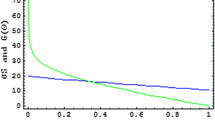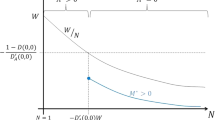Abstract
We show that the availability of adaptation can be welfare-reducing in the non-cooperative equilibrium in a setting with multiple countries. Adaptation is a private good while abatement is a public good. This means that substitution out of abatement and into adaptation by any one country imposes a negative externality on all other countries. The potentially deleterious impact of adaptation is asymmetric: small economies are most likely to be hurt by the availability of adaptation because they control a small fraction of global emissions relative to the biggest emitters.





Similar content being viewed by others
Notes
All data are from the World Bank’s World Development Indicators 2013. GDP is calculated in current US dollars.
Some defensive measures (such as geoengineering) may have significant spillover effects on other countries, possibly negative; see Barrett (2008b). Here we restrict attention to purely private defensive measures.
Ebert and Welsch (2011 and 2012) derive a more a general result. They assume that damage is strictly convex in global emissions, and this means that emissions are strategic substitutes when adaptation is not available; the best-response functions are negatively-sloped. The introduction of adaptation then creates the possibility that emissions become strategic complements but the slopes of the best-response functions depend on the convexity of the damage function relative to the effectiveness of adaptation. We have assumed a linear damage function here because it allows us to derive closed-form solutions for the equilibrium while still highlighting the impact of adaptation on the nature of the strategic interaction between countries.
We are grateful to an anonymous referee for drawing our attention to this point and its implications.
References
Agrawala S, Bosello F, Carraro C, De Cian E, Lanzi E (2011) Adaptating to climate change: costs, benefits and modelling approaches. Int Rev Environ Resour Econ 5:245–284
Barrett S (2003) Environment and statecraft: the strategy of environmental treaty-making. Oxford University Press, Oxford
Barrett S (2008a) Dikes versus windmills: climate treaties and adaptation, unpublished manuscript, Johns Hopkins University, School of Advanced International Studies
Barrett S (2008b) The incredible economics of geoengineering. Environ Resour Econ 39:45–54
Buob S, Stephan G (2011) To mitigate or to adapt: how to confront global climate change. Eur J Polit Econ 27:1–16
Buob S, Stephan G (2013) On the incentive compatibility of funding adaptation. Clim Change Econ 04:1–18
Bréchet T, Hritonenko N, Yatsenko Y (2010) Adaptation and mitigation in long-term climate policy. Environ Resour Econ 55:217–243
Ebert U, Welsch H (2011) Optimal response functions in global pollution problems can be upward sloping: accounting for adaptation. Environ Econ Policy Stud 13:129–138
Ebert U, Welsch H (2012) Adaptation and mitigation in global pollution problems: economic impacts of productivity, sensitivity, and adaptive capacity. Environ Resour Econ 52:49–64
Ingham A, Ma J, Ulph AM (2007) Climate change, mitigation and adaptation with uncertainty and learning. Energy Policy 35:5354–5369
Ingham A, Ma J, Ulph AM (2013) Can adaptation and mitigation be complements? Clim Change 120:39–53
Kane S, Shogren JF (2000) Linking adaptation and mitigation in climate change policy. Clim Change 45:75–102
Lecocq F, Shalizi Z (2007) Balancing expenditures on mitigation and adaptation to climate change: an explorations of issues relevant for developing countries, World Bank Policy Research Working Paper, No 4299
Tulkens H, van Steenberghe V (2009) Mitigation, adaptation, suffering. In: Search of the right mix in the face of climate change, CORE Discussion Paper, No. 054
United Nations Development Programme (2007) Fighting climate change: human solidarity in a divided world, Human Development Report 2007/2008. UNDP, New York
Yohe GW, Strzepeck K (2007) Adaptation and mitigation as complementary tools for reducing the risk of climate impacts. Mitig Adapt Strat Glob Change 12:727–739
Author information
Authors and Affiliations
Corresponding author
Appendix
Appendix
1.1 Proof of Proposition 1
The first-order conditions for \(x_i\) and \(a_i\) are, respectively,
and
From (23) we obtain
Thus, adaptation is identical across countries. Substituting \(a\) from (24) for \(a_j\) in (22), and rearranging, we obtain
Thus, technologies are identical across countries. Substituting \(x\) from (25) for \(x_j \) in (24), and rearranging, we obtain
Solving for \(a^{**}\) yields
Finally, substituting \(a^{**}\) for \(a\) in (25) yields
Solving for the conditions under which \(a^{**}\in [0,1]\) and \(x^{**}\in [0,1]\) yields the three parts of Proposition 1. It is straightforward to show that second-order conditions are satisfied. \(\square \)
1.2 Proof of Proposition 2
The first-order conditions for \(x_i\) and \(a_i\) are, respectively,
and
Solving (29) and (30) yields best-response functions for \(x_i\) and \(a_i\). These are, respectively,
and
From (31) we can obtain the best-response function in terms of emissions:
Setting \(E_{-i} = E-e_i\) in (33) and rearranging to make \(e_i\) the subject, we have
Summing across i allows us to solve for the equilibrium \(E\):
Setting \(E=E^{\wedge } \) in (34), we can then solve for the equilibrium \(\hat{{e}}_i \):
Then from (36) we can obtain
Substituting \(\hat{{x}}_i\) for \(x_i\) in (29) then allows us to solve for \(a_i\):
Assumption 1 (from Sect. 4) ensures that these solutions are interior, that second-order conditions hold, and that the equilibrium is stable. We can then express \(\hat{{e}}_i =(1-\hat{{x}}_i )y_i \) as \(\hat{{e}}_i =y_i -\phi y_i^2 \), where
as reported in the text.\(\square \)
1.3 Proof of Proposition 3
(a) Equilibrium domestic cost for country \(i\) is
In an interior equilibrium, \(x_i , a_i\) and \(E\) are evaluated at their equilibrium values given by (37), (38) and (35) respectively. It will prove useful to express this cost function in terms of \(\phi \):
where \(\phi \) is given by (39). The second bracketed term can be expressed as
so it must be positive if the equilibrium is interior.
Differentiating \(C(y_i ,\theta )\) with respect to \(\theta \) yields
where
and
at an interior equilibrium. Thus, \(\partial C/\partial \theta >0\) for \(y_i^2 >\tilde{s}\) and \(\partial C/\partial \theta <0\) for \(y_i^2 <\tilde{s}\).
(b) Making adaptation universally unavailable is equivalent to taking the limit
Making this substitution for \(\phi \) in (41) yields cost for country \(i\) when adaptation is universally unavailable :
where the second bracketed term must be positive in an interior equilibrium. Setting \(C(y_i ,\theta )=C_0 (y_i )\) and solving for \(y_i^2 \) yields a critical threshold denoted
Taking the difference \(\tilde{s}-\bar{{s}}\) yields
This is strictly positive at an interior equilibrium for any finite \(\theta \) since \(\partial \phi /\partial \theta >0\). Thus, \(\bar{{s}}<\tilde{s}\). Since \(\partial C/\partial \theta <0\) for \(y_i^2 <\tilde{s}\) (by part (a) above), it follows that \(\partial C/\partial \theta <0\) at \(y_i^2 =\bar{{s}}\). That is, \(C(y_i ,\theta )\) crosses \(C_0 (y_i )\) at \(y_i^2 =\bar{{s}}\) from above. Thus, \(C_0 (y_i )<C(y_i ,\theta )\) for \(y_i^2 <\bar{{s}}\) and \(C_0 (y_i )>C(y_i ,\theta )\) for \(y_i^2 >\bar{{s}}\).\(\square \)
1.4 Proof of Proposition 4
(a) Total cost for country \(i\) is given by (41). Summing across \(i\) yields total global cost:
where \(Q=\sum _{i=1}^N {y_i^3 } \). Differentiating \(G(Y,\theta )\) with respect to \(\theta \) yields
where
and \(\partial \phi /\partial \theta >0\) is given by (45). Thus, \(\partial G/\partial \theta >0\) for \(Q>\tilde{Q}\) and \(\partial G/\partial \theta <0\) for \(Q<\tilde{Q}\).
(b) Taking the limit of \(G(Y,\theta )\) as \(\theta \rightarrow \infty \) yields total global cost when adaptation is universally unavailable:
Setting \(G(Y,\theta )=G_0 (Y)\) and solving for \(Q\) yields a critical threshold denoted
Taking the difference \(\tilde{Q}-\bar{{Q}}\) yields
This is strictly positive at an interior equilibrium for any finite \(\theta \) since \(\partial \phi /\partial \theta >0\). Thus, \(\bar{{Q}}<\tilde{Q}\). Since \(\partial G/\partial \theta <0\) for \(Q<\tilde{Q}\) (by part (a) above), it follows that \(\partial G/\partial \theta <0\) at \(Q=\bar{{Q}}\). That is, \(G(Y,\theta )\) crosses \(G_0 (Y)\) at \(Q=\bar{{Q}}\) from above. Thus, \(G_0 (Y)<G(Y,\theta )\) for \(Q<\bar{{Q}}\) and \(G_0 (Y)>G(Y,\theta )\) for \(Q>\bar{{Q}}\).\(\square \)
Rights and permissions
About this article
Cite this article
Farnham, M., Kennedy, P. Adapting to Climate Change: Equilibrium Welfare Implications for Large and Small Economies. Environ Resource Econ 61, 345–363 (2015). https://doi.org/10.1007/s10640-014-9795-7
Accepted:
Published:
Issue Date:
DOI: https://doi.org/10.1007/s10640-014-9795-7




